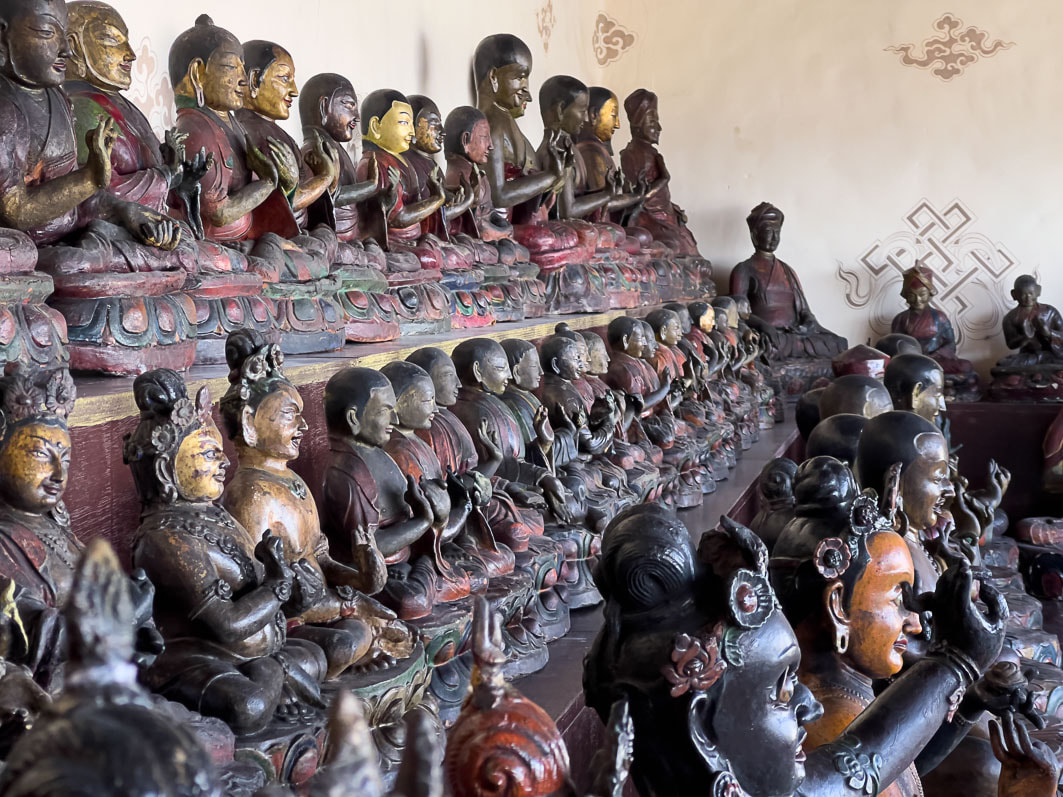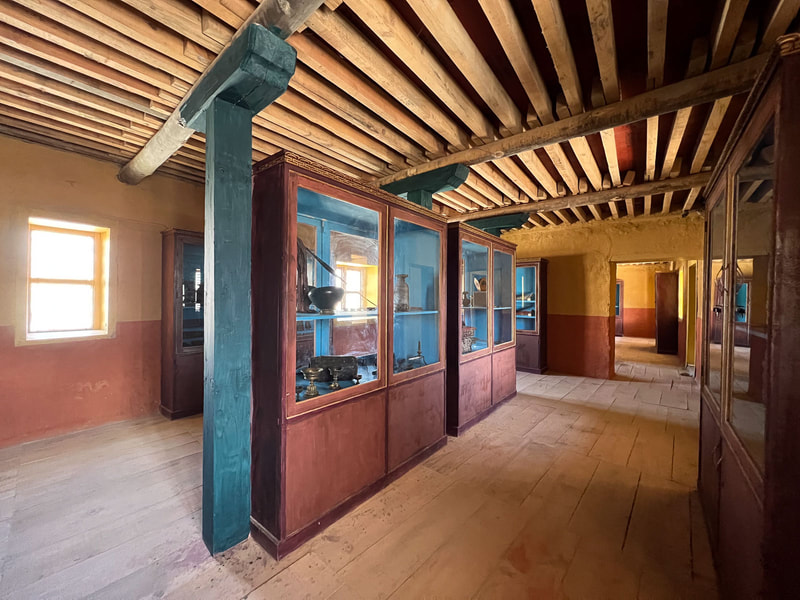COLLECTION of Namgyal Monastery
Namgyal Monastery lies at an altitude of 3850 meters on the hill immediately west of Lo Mangthang, just above a village of the same name. It is unclear when Namgyal monastery was founded and what its original affiliation has been, but at the time of Ngorchen Kunga Zangpo’s second visit to Mustang (1436–37) he initiated the restoration of old Namgyal Chöde (“the dharma area of Namgyal”) monastery and its expansion. At the time of his third visit (1447–49) the new monastic centre was referred to as Thubten Dargyeling (“the sanctuary in which the Buddhas’s teachings flourishes”) and it could house as many as 1000 monks. Apparently, this number was reached by summoning the monks from three earlier foundations to this new centre. Since then, Namgyal remained a seat of the Ngor School, a sub-branch of the Sakya School, which is well known for its high quality art production.
While nothing of Namgyal's architectural elements reminds of this history and the monastery is in the process of being renewed again, its collection is a vivid reminder of its historical importance.
The collection of portable objects at Namgyal monastery, largely consisting of sculptures and books, is impressive. Of approximately 370 objects at least 300 are sculptures. Approximately half of these are metal images while the rest is produced in diverse forms of papier mâché like materials. Of the metal images at least half bear dedication inscriptions, usually naming the depicted figure, the benefactor and the religious intention of the commission. In addition, the collection contains almost 80 ancient books with some form of artwork, be it carved or painted covers, illuminations, silk curtains or repoussée work, and usually combinations thereof. There is, however, only one ancient Tibetan scroll painting (thangka), a mid-to late-15th century painting of the Vajradhātu mandala in urgent need of restoration.
Originally, the collection was displayed in two areas, the main Assembly Hall and the Lamdré Lhakhang, but by 2012, the sculptures of the Lamdré Lhakhang had been moved to the Assembly Hall. It is at this stage that the collection was documented in detail.
While nothing of Namgyal's architectural elements reminds of this history and the monastery is in the process of being renewed again, its collection is a vivid reminder of its historical importance.
The collection of portable objects at Namgyal monastery, largely consisting of sculptures and books, is impressive. Of approximately 370 objects at least 300 are sculptures. Approximately half of these are metal images while the rest is produced in diverse forms of papier mâché like materials. Of the metal images at least half bear dedication inscriptions, usually naming the depicted figure, the benefactor and the religious intention of the commission. In addition, the collection contains almost 80 ancient books with some form of artwork, be it carved or painted covers, illuminations, silk curtains or repoussée work, and usually combinations thereof. There is, however, only one ancient Tibetan scroll painting (thangka), a mid-to late-15th century painting of the Vajradhātu mandala in urgent need of restoration.
Originally, the collection was displayed in two areas, the main Assembly Hall and the Lamdré Lhakhang, but by 2012, the sculptures of the Lamdré Lhakhang had been moved to the Assembly Hall. It is at this stage that the collection was documented in detail.
Page of an early fourteenth-century Sūtra collection in 30 volumes with at least four illuminations in each volume; Namgyal Monastery. This and a second collection have been published in the following book:
- Luczanits, Christian, and Markus Viehbeck. 2021. Two Illuminated Text Collections of Namgyal Monastery. A Study of Early Buddhist Art and Literature in Mustang. Vajra Academic. Kathmandu, Nepal: Vajra Books.
- Also available Open Access.
New Lamdré Lhakhang
The complete rebuilding of the monastic quarters surrounding the main temple of Namgyal Monastery in Mustang since 2012 included the destruction of the old temple for the Lamdré or “Path with the Fruit” lineage figures that was integrated within that structure. Housing sculptures of at least six Lamdré lineages of different size the temple had a unique atmosphere.
Among these a papier mâché set of comparatively large sculptures stands out in terms of its quality and expressiveness. Although the varnish applied to the sculptures and obvious later repairs, such as on the sculpture of Nairātmyā, affect their aesthetic impression, their early date and original quality is without doubt. In fact, this set is only the third large size Lamdré set known after those of the Gyantsé Lamdré Temple and the repoussé sculptures today in Mindroling Monastery, both dating to the 15th century. Featuring later Ngor teachers with their typical typical hat, the Namgyal set likely dates to the 16th century.
The Norbusum Foundation has been tasked to plan and implement the new Lamdré Lhakhang on the upper floor of the new temple, the construction of which has been finished in 2020. In the new temple, the sculptures will be displayed on a central stepped structure that enables a clear view of the sculptures as well as their ritual circumambulation. This plan, thus, takes its future usage by both religious and tourist visitors into account and combines aspects of the original display of these images with aspects of a modern museum display.
Among these a papier mâché set of comparatively large sculptures stands out in terms of its quality and expressiveness. Although the varnish applied to the sculptures and obvious later repairs, such as on the sculpture of Nairātmyā, affect their aesthetic impression, their early date and original quality is without doubt. In fact, this set is only the third large size Lamdré set known after those of the Gyantsé Lamdré Temple and the repoussé sculptures today in Mindroling Monastery, both dating to the 15th century. Featuring later Ngor teachers with their typical typical hat, the Namgyal set likely dates to the 16th century.
The Norbusum Foundation has been tasked to plan and implement the new Lamdré Lhakhang on the upper floor of the new temple, the construction of which has been finished in 2020. In the new temple, the sculptures will be displayed on a central stepped structure that enables a clear view of the sculptures as well as their ritual circumambulation. This plan, thus, takes its future usage by both religious and tourist visitors into account and combines aspects of the original display of these images with aspects of a modern museum display.
Namgyal Museum
In recent years Namgyal Monastery built a two-room museum building in front of the temple complex with external funding. While the monastery has planned this space without the involvement of the Norbusum Foundation, it has approached us to come up with a concept for its display. The latter is now guided by an educational arrangement leading from utilitarian items to the variety of deities characteristic of Tibetan Buddhism. The objects it displays are chosen to emphasise their variety, but for the deities papier mâché, clay and wooden images must be used predominantly. Illuminated manuscripts and painted scrolls are included on a rotating basis. The Museum has been inaugurated in June 2023 by HH the 42nd Sakya Trizin Ratna Vajra Rinpoche.










